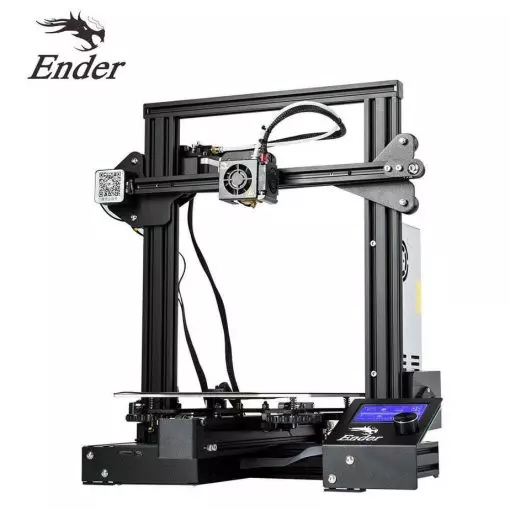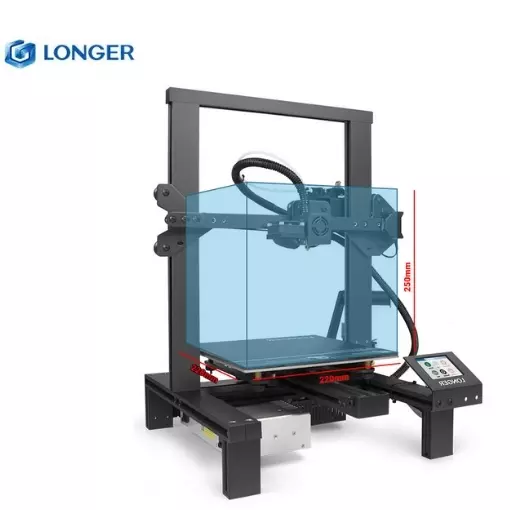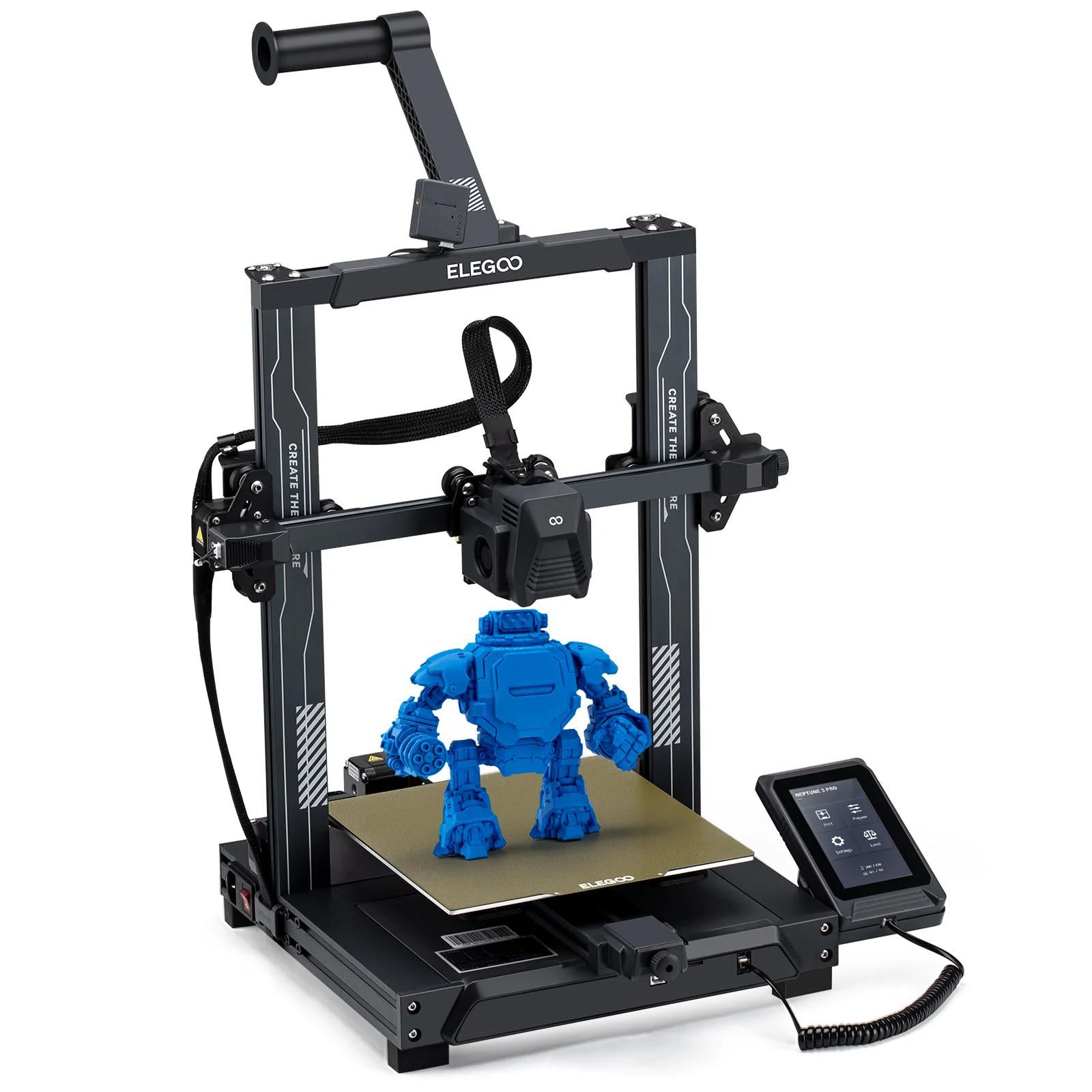Compare Ender 3 vs LK4 vs Neptune 3 PRO
Comparison between the best 3D printers
Choose the best 3D printer at the best price. The cheapest 3D printers are here.
Buy a 3D printer here with 3D Fila.
 |
 |
 |
|
| Model | Ender 3[BUY Ender 3] |
LK4 |
Neptune 3 PRO |
| Printing Material | Filament | Filament | Filament |
| Estimated price | $210,00 | $200,00 | $230,00 |
| Fabricante | Creality 3D | Longer 3D | Elegoo |
| Release Year | 2018 | 2019 | 2022 |
| Print Volume [mm] | 220x220x250 | 220x220x250 | 225x225x280 |
| Printer Size [mm] | 440x440x465 | 402x425x505 | 445x515x475 |
| Weight [kg] | 6,62 | 7,8 | 8,1 |
| Power Loss Recovery | NO | YES | YES |
| Enclosed printer | NO | NO | NO |
| Bed Leveling | Manual | Manual com Assistência | Automatic |
| Filament End Sensor | NO | YES | YES |
| Bed type | Heated | Heated | Heated |
| Power supply system | Bowden | Bowden | Direct Drive |
| Standard nozzle | 0,4 | 0,4 | 0,4 |
| Maximum Nozzle Temperature [°C] | 255 | 250 | 260 |
| Maximum Bed Temperature [°C] | 110 | 100 | 100 |
| Maximum printing speed [mm/s] | 180 | 120 | 80 |
| Filament holder | YES | YES | YES |
| Camera for supervision | NO | NO | NO |
| Recommended filaments | PLA, TPU, ABS, PETG | PLA, TPU, ABS, PETG | PLA, PETG, Tritan, Flex, ABS |
| Recommended slicers | Cura, Simplify, Slic3r | Cura, Simplify, Slic3r | Cura, Simplify, Slic3r, IdeaMaker e outros |
| Maximum Resolution [mm] | 0,1 | 0,1 | 0,1 |
| Processor | 8 bits | 8 bits | |
| Display | Mono | Touchscreen TFT 2,8'' | Display touchscreen 4,3'' |
| Power Supply | 24V / 270W | 12V / 360W | 250 |
| Connectivity | SD / USB | SD / USB | |
| Operating systems | Windows, Mac, Linux | Windows, Mac, Linux | Windows, Mac, Linux |
| Date of registration in the system | 2021-04-13 | 2021-04-15 | 2023-03-02 |
| Release date | 2018 | 2019 | 2022 |
| Extra features | The Ender 3 V1 is a DIY assembly 3D printer, a sales leader since 2017, standing out for its cost-benefit. With a wide printing capacity, it has a CNC machined structure for precision and stability. It offers high-precision prints with low noise, thanks to its innovative V-profile and pulleys. It has a self-adhesive magnetic platform for easy removal of models and excellent adhesion. The Ender 3 heats up quickly, reaching 100°C in 5 minutes, ideal for agile prints. It includes protection against power failures, allowing you to resume printing after interruptions, saving time and material. | The Longer LK4 is a versatile 3D printer capable of working with a wide range of filaments, such as PLA, ABS, TPU, copper, wood and carbon fiber, thanks to its 0.4mm nozzle and heated bed up to 110°C. With a printing accuracy of between 0.05-0.4mm, it stands out for its solid construction with an aluminum frame, weighing around 7kg, and a robust 24V and 15A power supply. The kit includes an Allen key, a 7/10 key, a microSD card with USB adapter, a spatula, cable ties, a power cable, 5m of filament and a spare filament end sensor. Assembly is simplified, with around 90% of the equipment pre-assembled, and detailed instructions assist in the process. Special features include print recovery after power failure, a filament end sensor, a super-adhesive printing surface and an intuitive color touchscreen display. The design features smooth profiles for easy assembly, and the position of the filament holder optimizes the filament path to the extruder. The LK4 is a solid choice for 3D printing enthusiasts looking for quality and versatility. | The Elegoo Neptune 3 Pro printer stands out for its easy assembly and automatic bed leveling, ideal for different levels of users. Equipped with a direct-drive extruder and dual gears, it offers excellent adhesion to slippery materials such as TPU. It incorporates dual screws on the Z-axis, ensuring stable prints, and features an integrated task light for improved visibility. With a PEI-coated build plate and a detachable touchscreen, it combines functionality and convenience. The printer also features an efficient cooling system, filament sensor and a simplified user interface. |
| Support for multiple colors and materials (AMS and CFS) | NO | NO | NO |
Notes * |
|||
| Cost-benefit | 6 / 10 | 7 / 10 | 7 / 10 |
| Hardware | 0.5 / 10 | 2 / 10 | 2.8 / 10 |
| Screen | . | . | . |
| Print volume | 3 / 10 | 3 / 10 | 3 / 10 |
| Performance | 1 / 10 | 1 / 10 | 0 / 10 |
| [BUY Ender 3] |
Conclusion |
| In summary, the comparison of the three 3D printers—Ender 3, LK4, and Neptune 3 Pro—highlights distinct advantages and considerations relevant to potential buyers. The **Ender 3**, while the oldest of the trio, remains a popular choice due to its strong cost-benefit ratio, good print quality, and widely available community support. However, it lacks power loss recovery and automated bed leveling, which could be a downside for less experienced users. The **Longer LK4** offers a more modern feature set with power loss recovery, a filament end sensor, and simplified assembly, making it suitable for hobbyists and those seeking versatility. Its solid construction and ability to work with various materials also add to its appeal. Nevertheless, its print speed is lower compared to the Ender 3. On the other hand, the **Elegoo Neptune 3 Pro** stands out for its advanced features, such as automatic bed leveling and a direct-drive extruder, making it particularly effective for difficult materials like TPU. While it has a slightly higher price point and lower maximum printing speed, its modern design and intuitive touchscreen interface make it user-friendly. When considering pricing, the Ender 3 is the most cost-effective option, followed closely by the LK4, while the Neptune 3 Pro sits at a premium. Ultimately, buyers should weigh the importance of features versus price, balancing their budget with the desired capabilities for their specific 3D printing needs. For those looking for a solid introduction to 3D printing, the Ender 3 remains a prevalent choice, while the LK4 and Neptune 3 Pro cater more to users seeking enhanced functionality and ease of use. |

